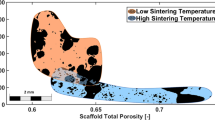Abstract
The mechanical behaviour of polymer scaffolds plays a vital role in their successful use in bone tissue engineering. The present study utilised novel sintered polymer scaffolds prepared using temperature-sensitive poly(dl-lactic acid-co-glycolic acid)/poly(ethylene glycol) particles. The microstructure of these scaffolds was monitored under compressive strain by image-guided failure assessment (IGFA), which combined synchrotron radiation computed tomography (SR CT) and in situ micro-compression. Three-dimensional CT data sets of scaffolds subjected to a strain rate of 0.01%/s illustrated particle movement within the scaffolds with no deformation or cracking. When compressed using a higher strain rate of 0.02%/s particle movement was more pronounced and cracks between sintered particles were observed. The results from this study demonstrate that IGFA based on simultaneous SR CT imaging and micro-compression testing is a useful tool for assessing structural and mechanical scaffold properties, leading to further insight into structure–function relationships in scaffolds for bone tissue engineering applications.





Similar content being viewed by others
References
Mosekilde L. Age-related changes in vertebral trabecular bone architecture—assessed by a new method. Bone. 1988;9:247–50.
Müller R, Hannan M, Smith SY, Bauss F. Intermittent ibandronate preserves bone quality and bone strength in the lumbar spine after 16 months of treatment in the ovariectomized cynomolgus monkey. J Bone Miner Res. 2004;19:1787–96.
Goulet RW, Goldstein SA, Ciarelli MJ, Kuhn JL, Brown MB, Feldkamp LA. The relationship between the structural and orthogonal compressive properties of trabecular bone. J Biomech. 1994;27:375–89.
Langer R, Vacanti JP. Tissue engineering. Science. 1993;260:920–6.
Salgado AJ, Coutinho OP, Reis RL. Bone tissue engineering: state of the art and future trends. Macromol Biosci. 2004;4:743–65.
Jones JR, Lee PD, Hench LL. Heirarchical porous materials for tissue engineering. Philos Transact A Math Phys Eng Sci. 2006;364:263–81.
Yang S, Leong KF, Du Z, Chua CK. The design of scaffolds for use in tissue engineering. Part I. Tradit Factors. 2001;7:679–89.
Bignon A, Chouteau J, Chevalier J, Fantozzi G, Carret JP, Chavassieux P, Boivin G, Melin M, Hartmann D. Effect of micro- and macroporosity of bone substitutes on their mechanical properties and cellular response. J Mater Sci Mater Med. 2003;14:1089–97.
Jin QM, Takita H, Kohgo T, Atsumi K, Itoh H, Kuboki Y. Effects of geometry of hydroxyapatite as a cell substratum in BMP-induced ectopic bone formation. J Biomed Mater Res A. 2000;51:491–9.
Kaito T, Myoui A, Takaoka K, Saito N, Nishikawa M, Tamai N, Ohgushi H, Yoshikawa H. Potentiation of the activity of bone morphogenetic protein-2 in bone regeneration by a PLA/PEG/hydroxyapatite composite. Biomaterials. 2005;26:73–9.
Marra KG, Szem JW, Kumta PN, DiMilla PA, Weiss LE. In vitro analysis of biodegradable polymer blend/hydroxyapatite composites for bone tissue engineering. J Biomed Mater Res. 1999;47:324–35.
Babout L, Ludwig W, Maire E, Buffiere JY. Damage assessment in metallic structural materials using high resolution synchrotron X-ray tomography. Nucl Instrum Methods Phys Res, B Beam Interact Mater Atoms. 2003;200:303–7.
Elliott JA, Windle AH, Hobdell JR, Eeckhaut G, Oldman RJ, Ludwig W, Boller E, Cloetens P, Baruchel J. In situ deformation of an open-cell flexible polyurethane foam characterised by 3D computed microtomography. J Mater Sci. 2002;37:1547–55.
Müller R, Gerber SC, Hayes WC. Micro-compression: a novel technique for the non-destructive assessment of local bone failure. Technol Health Care. 1998;6:433–44.
Nazarian A, Müller R. Time-lapsed microstructural imaging of bone failure behaviour. J Biomech. 2004;37:55–65.
Thurner PJ, Wyss P, Voide R, Stauber M, Stampanoni M, Sennhauser U, Müller R. Time-lapsed investigation of three-dimensional failure and damage accumulation in trabecular bone using synchrotron light. Bone. 2006;39:289–99.
Voide R, Schneider P, Stauber M, Wyss P, Stampanoni M, Sennhauser U, van Lenthe GH, Müller R. Time-lapsed assessment of microcrack initiation and propagation in murine cortical bone at submicrometer resolution. Bone. 2009;45:164–73.
Schneider P, Levchuk A, Müller R. Automated micro-compression device for dynamic image-guided failure assessment of bone ultrastructure and bone microdamage. Biomed Tech. 2010;55:8–10.
Coombes AG, Heckman JD. Gel casting of resorbable polymers 2. In vitro degradation of bone graft substitutes. Biomaterials. 1992;13:297–307.
Howard D, Buttery LD, Shakesheff KM, Roberts SJ. Tissue engineering: strategies, stem cells and scaffolds. J Anat. 2008;213:66–72.
Hamilton L, France RM, Shakesheff KM. Development of an injectable scaffold for application in regenerative medicine to deliver stem cells and growth factors. J Pharm Pharmacol. 2006;58:52–3.
Stampanoni M, Groso A, Isenegger A, Mikuljan G, Chen Q, Meister D, Lange M, Betemps R, Henein S, Abela R. TOMCAT: a beamline for tomographic microscopy and coherent radiology experiments. AIP Conf Proc. 2007;879:848–51.
Misch CE, Qu Z, Bidez MW. Mechanical properties of trabecular bone in the human mandible: implications for dental implant treatment planning and surgical placement. J Oral Maxillofac Surg. 1999;57:700–6.
Teo JC, Chui CK, Wang ZL, Ong SH, Yan CH, Wang SC, Wong HK, Teoh SH. Heterogenous meshing and biomechanical modelling of human spine. Med Eng Phys. 2007;29:277–90.
Kopperdahl DL, Keaveny TM. Yield strain behaviour of trabecular bone. J Biomech. 1998;31:601–8.
Charles-Harris M, del Valle S, Hentges E, Bleuet P, Lacroix D, Planell JA. Mechanical and structural characterisation of completely degradable polylactic acid/calcium phosphate glass scaffolds. Biomaterials. 2007;28:4429–38.
Yue S, Lee PD, Poologasundarampillai G, Yao Z, Rockett P, Devlin AH, Mitchell CA, Konerding MA, Jones JR. Synchrotron X-ray microtomography for assessment of bone tissue scaffolds. J Mater Sci Mater Med. 2010;21:847–53.
Acknowledgments
This study has benefited from research funding of the European Union’s access programme 20090893 at the SLS (Paul Scherrer Institut, Villigen, Switzerland) as well as from the European Union’s Seventh Framework Programme in the project Angioscaff NMP-LA-2008-214402. SR CT measurements were carried out at the TOMCAT beamline at the Swiss Light Source with assistance from Dr Julie Fife. The authors also acknowledge Dr Kathryn Stok for her help and advice.
Author information
Authors and Affiliations
Corresponding author
Rights and permissions
About this article
Cite this article
Dhillon, A., Schneider, P., Kuhn, G. et al. Analysis of sintered polymer scaffolds using concomitant synchrotron computed tomography and in situ mechanical testing. J Mater Sci: Mater Med 22, 2599–2605 (2011). https://doi.org/10.1007/s10856-011-4443-z
Received:
Accepted:
Published:
Issue Date:
DOI: https://doi.org/10.1007/s10856-011-4443-z




